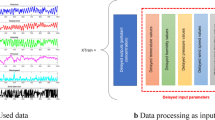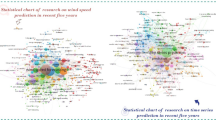Abstract
The future depends upon the wind energy for the generation of electrical energy. The availability of the wind is either in the coastal areas or in the mountain areas at a suitable altitude. The present research is focused on wind energy availability in the mountain areas. For this purpose, a site has been selected for data collection of the wind in the Himalayan Range called Pir Panjal Range and at a height of 1200 m from the sea level. The sites which have been selected are in such ways that there is no obstruction offered to the wind flow. These are naturally occurring sites and purposed to be suitable for wind energy extraction, which is also an objective of the present research. The data is collected as wind speed, temperature and air density which is used to forecast the wind energy. The forecasting helps in maintain the reliability of electricity at the output. It also gives us the future prospects of wind energy and generation through it in near future; so that, the required planning can be done to improve the reliability of the system. The Artificial Neural Network (ANN) has been used to forecast wind energy. The ANN algorithm, which is used in this research work, uses 30 days data of wind speed, temperature and air density for training purpose and forecasting of the wind energy. The programming has been done in MATLAB environment, whereas the results have been evaluated and compared with actual data for validation.







Similar content being viewed by others
References
Ackermann T.(ed) (2005) Wind power in power systems. Wiley
Alawaji SH, Eugenio NN, Elani UA (1996) Wind energy resource assessment in Saudi Arabia: part II: data collection and analysis. Renew Energy 9:818–821
Amarasinghe AG, Perera EN (2020) Modeling predictive suitability to determine potential areas for establishing wind power plants in Sri Lanka. Model Earth Syst Environ 13:1–2
Amirat Y, Benbouzid MEH (2007) Survey paper generators for wind energy conversion systems: state of the art and coming attractions. J Electr Syst 3:26–38
Bhutta MMA, Hayat N, Farooq AU, Ali Z, Jamil SR, Hussain Z (2012) Vertical axis wind turbine–A review of various configurations and design techniques. Renew Sustain Energy Rev 16:1926–1939
Biswas S, Sinha M (2020) Performances of deep learning models for Indian Ocean wind speed prediction. Model Earth Syst Environ 19:1–23
Bludszuweit H, Domínguez-Navarro JA, Llombart A (2008) Statistical analysis of wind power forecast error. IEEE Trans Power Syst 23:983–991
Borowy BS, Salameh ZM (1997) Dynamic response of a stand-alone wind energy conversion system with battery energy storage to a wind gust. IEEE Trans Energy Convers 12:73–78
Dabiri JO (2011) Potential order-of-magnitude enhancement of wind farm power density via counter-rotating vertical-axis wind turbine arrays. J Renew Sustain Energy 3:043104
Datta R, Ranganathan VT (2003) A method of tracking the peak power points for a variable speed wind energy conversion system. IEEE Trans Energy Convers 18:163–168
El-Fouly TH, El-Saadany EF, Salama MM (2008) One day ahead prediction of wind speed and direction. IEEE Trans Energy Convers 23:191–201
Eriksson S, Bernhoff H, Leijon M (2008) Evaluation of different turbine concepts for wind power. Renew Sustain Energy Rev 12:1419–1434
Essandoh EO (2012) Wind data collection and analysis in Kumasi. PhD thesis, Kwame Nkrumah university of Science and Technology.
Goldberg, Steven B, (1995) Vertical-axis wind turbine with a twisted blade configuration. U.S. Patent 5,405,246.
Hasche B, Keane A, O’Malley M (2011) Capacity value of wind power, calculation, and data requirements: the Irish power system case. IEEE Trans Power Syst 26:420–430
Heddam S (2019) Development of air–soil temperature model using computational intelligence paradigms: artificial neural network versus multiple linear regression. Model Earth Syst Environ 5(3):747–751
Herbert GJ, Iniyan S, Sreevalsan E, Rajapandian S (2007) A review of wind energy technologies. Renew Sustain Energy Rev 11:1117–1145
Jung SK, McDonald K (2011) Visual gene developer: fully programmable bioinformatics software for synthetic gene optimization. BMC Bioinform 12:340
Karki R, Billinton R (2004) Cost-effective wind energy utilization for reliable power supply. IEEE Trans Energy Convers 19:435–440
Kassem Y, Gökçekuş H, Janbein W (2020) Predictive model and assessment of the potential for wind and solar power in Rayak region, Lebanon. Model Earth Syst Environ 3:1–28
KassemY GH, Zeitoun M (2019) Modeling of techno-economic assessment on wind energy potential at three selected coastal regions in Lebanon. Model Earth Syst Environ 5(3):1037–1049
Keane A, Milligan M, Dent CJ, Hasche B, D’Annunzio C, Dragoon K, Holttinen H, Samaan N, Soder L, O’Malley M (2011) Capacity value of wind power. IEEE Trans Power Syst 26:564–572
Kellogg WD, Nehrir MH, Venkataramanan G, Gerez V (1998) Generation unit sizing and cost analysis for stand-alone wind, photovoltaic, and hybrid wind/PV systems. IEEE Trans Energy Convers 13:70–75
Khan MA, Çamur H, Kassem Y (2019) Modeling predictive assessment of wind energy potential as a power generation sources at some selected locations in Pakistan. Model Earth Syst Environ 5(2):555–569
Koutroulis E, Kalaitzakis K (2006) Design of a maximum power tracking system for wind-energy-conversion applications. IEEE Trans Industr Electron 53:486–494
Kusiak A, Zhang Z (2010) Short-horizon prediction of wind power: A data-driven approach. IEEE Trans Energy Convers 25:1112–1122
Kusiak A, Zheng H, Song Z (2009) Short-term prediction of wind farm power: a data mining approach. IEEE Trans Energy Convers 24:125–136
Manwell JF, McGowan JG, Rogers AL (2010) Wind energy explained: theory design and application. Wiley
Murdoch A, Winkelman JR, Javid SH, Barton RS (1983) Control design and performance analysis of a 6 MW wind turbine-generator. IEEE Trans Power Appar Syst 5:1340–1347
Mwaura JI, Kenduiywo BK (2020) County level maize yield estimation using artificial neural network. Model Earth Syst Environ. https://doi.org/10.1007/s40808-020-00943-2
Naderi FM, Freilich MH, Long DG (1991) Space borne radar measurement of wind velocity over the ocean-an overview of the NSCAT scatter-meter system. Proc IEEE 79:850–866
Okon AN, Adewole SE, Uguma EM (2020) Artificial neural network model for reservoir petrophysical properties: porosity, permeability and water saturation prediction. Model Earth Syst Environ. https://doi.org/10.1007/s40808-020-01012-4
Osinowo AA, Okogbue EC, Eresanya EO, Akande OS (2017) Evaluation of wind potential and its trends in the mid-Atlantic. Model Earth Syst Environ 3(4):1199–1213
Potter CW, Negnevitsky M (2006) Very short-term wind forecasting for Tasmanian power generation. IEEE Trans Power Syst 21:965–972
Shams SR, Jahani A, Moeinaddini M, Khorasani N (2020) Air carbon monoxide forecasting using an artificial neural network in comparison with multiple regression. Model Earth Syst Environ 6(3):1467–1475
Sircar A, Thander B, Yadav K (2020) Stochastic modeling of earth’s hydrocarbon resources using artificial neural network. Model Earth Syst Environ 15:1–6
Tavner P (2012) Offshore wind turbines reliability availability and maintenance. The Institution of Engineering and Technology, London, UK
Taylor JW, McSharry PE, Buizza R (2009) Wind power density forecasting using ensemble predictions and time series models. IEEE Trans Energy Convers 24:775–782
ul Haq MA, Chand S, Sajjad MZ, Usman RM (2020) Evaluating the suitability of two parametric wind speed distributions: a case study from Pakistan. Model Earth Syst Environ 24:1–9
Wagh VM, Panaskar DB, Muley AA, Mukate SV, Lolage YP, Aamalawar ML (2016) Prediction of groundwater suitability for irrigation using artificial neural network model: a case study of Nanded tehsil, Maharashtra, India. Model Earth Syst Environ 2(4):1
Weisser D (2003) A wind energy analysis of Grenada: an estimation using the ‘Weibull’ density function. Renew Energy 28:1803–1812
Xia Y, Ahmed KH, Williams BW (2013) Wind turbine power coefficient analysis of a new maximum power point tracking technique. IEEE Trans Industr Electron 60:1122–1132
Yang HX, Lu L, Burnett J (2003) Weather data and probability analysis of hybrid photovoltaic–wind power generation systems in Hong Kong. Renew Energy 28:1813–1824
Yang W, Court R, Jiang J (2013) Wind turbine condition monitoring by the approach of SCADA data analysis. Renew Energy 53:365–376
Acknowledgement
The author wants to acknowledge the Department of Electrical Engineering, BGSB University by helping and making this research successful. I also acknowledge the students of Batch 2013 of Electrical Engineering Department for their support in collecting the useful data.
Author information
Authors and Affiliations
Corresponding author
Additional information
Publisher's Note
Springer Nature remains neutral with regard to jurisdictional claims in published maps and institutional affiliations.
Rights and permissions
About this article
Cite this article
Puri, V., Kumar, N. Wind energy forecasting using artificial neural network in himalayan region. Model. Earth Syst. Environ. 8, 59–68 (2022). https://doi.org/10.1007/s40808-020-01070-8
Received:
Accepted:
Published:
Issue Date:
DOI: https://doi.org/10.1007/s40808-020-01070-8




